Opinion: To Be Continued
Pursuing the performing arts is a path that requires determination and passion to overcome the risk of doing what one loves.
For some students, their final bow is not on their high school stage.
March 21, 2022
Most kids grow up singing Disney songs around the house, playing dress up, or making up little dance moves, but there’s a select few that make their childhood playtime into a real passion, one they’d even want to make a career.
Pursuing the performing arts is a lifestyle that is fueled by pure passion for the risk involved would easily be one to scare away those without it. But for those who love their art form, following any other career would be less than satisfactory. And the process associated with beginning higher education in the performing arts is one of levels upon levels of work and dedication with no guarantee of an outcome.
While the majority of students applying to college have a standard application with an array of letter of recommendations, supplemental essays, transcripts and the longest list of activities and volunteering, students applying for performing arts majors have one extra level. Auditions, auditions, and more auditions.
After applying academically to universities or conservatories, prospective students begin a two-step audition process, starting with prescreens that are filmed and submitted from September to December. Most colleges with theatre, voice, dance, and music programs require submission of pre-recorded videos of the students’ talents to decide whether they will be invited to a live audition. If the prescreens are rejected, that is the end of the journey with that specific school.
Once the results of the prescreens are received, the performers will have a finalized list of schools they will do live auditions for. Some students will audition for as many as thirty programs hoping to just get into one. From January to February, every weekend is filled with as many as four auditions either virtually–implemented for the pandemic–or in person.
Auditions serve as a chance to share talents, but also a chance for the audition panel to gain a sense of who the auditees are. For many programs, who the student is as a person can be even as important in the acceptance decision as their talent level. But while interviews are common, they are never guaranteed, making for an intimidating realization that the acceptance could be based solely on how the talent portion goes.
Finally, at the end of February, when the last audition is completed and the stress of audition season is over, the waiting period begins. During the month of March, decisions are sent out for performing arts programs. On average, programs will accept a small number of eight to thirty students out of hundreds of applicants, making for an anxiety-ridden month.
With a process that begins in early August persisting until early April, going into the performing arts is a nonstop journey filled with excitement and obstacles. However, the journey does have the possibility of not arriving at a reward. The reality is that many aspiring artists don’t receive any acceptance letters to their desired program. The difficult decision comes in whether to continue higher education for that year or, as many do, take gap years to further their training in their art and try again in auditions the next year.
Risk is often the first thought that comes to mind when anyone wants to make a career in the arts. It shouldn’t be ignored but instead embraced. The risk involved doesn’t start when a young performer goes into the job field for the first time. It starts with simply trying to be accepted into higher education programs for the performing arts. From the very beginning, making performance a career is risky, but it is so worth the thrill and love of doing it.
For performers, their art, whether it be acting, dancing, singing, or playing their instrument, can be the sole source of their happiness. And without attempting to make it a professional reality, the chance of spending every day doing what they love would be lost. Risk is only a word, not a barrier. Following true passion and pure happiness is the only option.
The process might be extensive and tiring at times, but the experience of leaping into the opportunity to make dreams a reality is irreplaceable. Pursuing the performing arts is for those with determination and a deep love for their art, for those willing to stare risk in the face and continue to walk forward.
Those of us walking this path know the difficulties ahead, but we cannot wait for the chance to continue learning, growing, and gaining experience where our true happiness lies.
_____________________________________________________________________________________
Editors’ note: All opinions expressed on The Uproar are a reflection solely of the beliefs of the bylined author and not the journalism program at NASH. We continue to welcome school-appropriate comments and guest articles.













